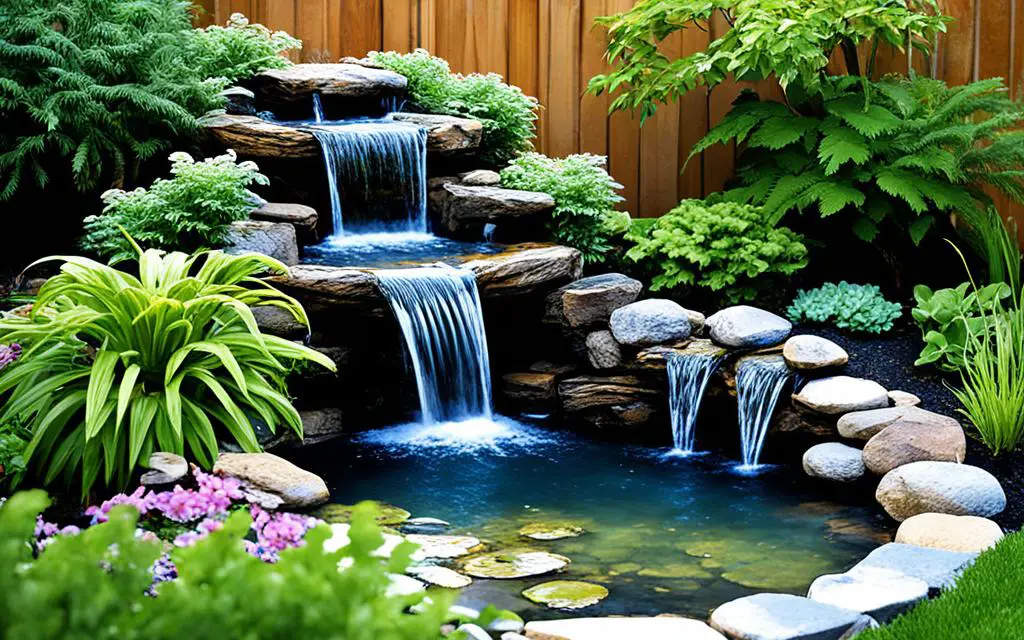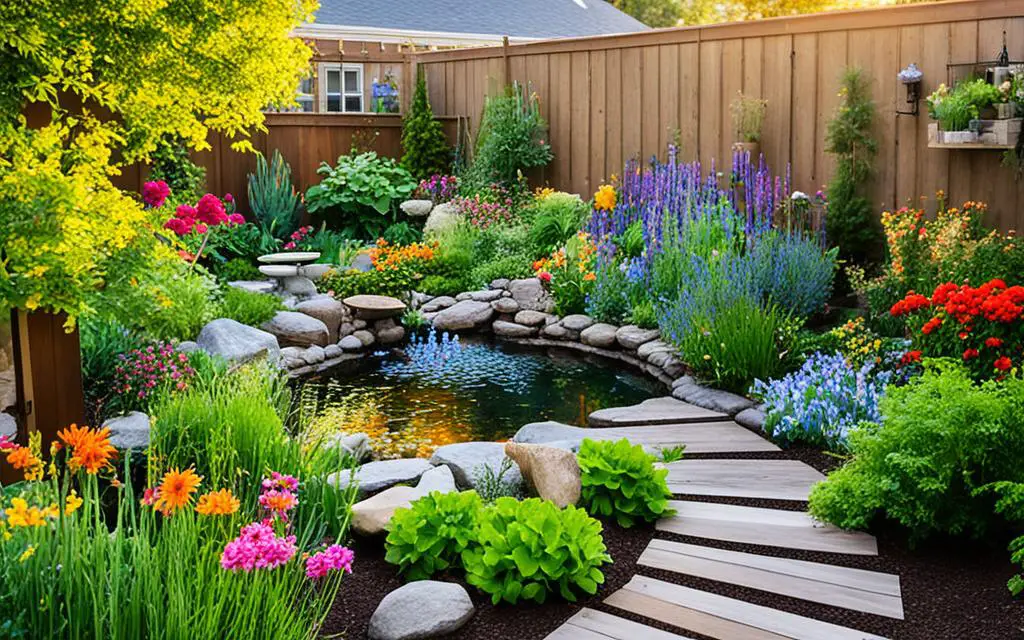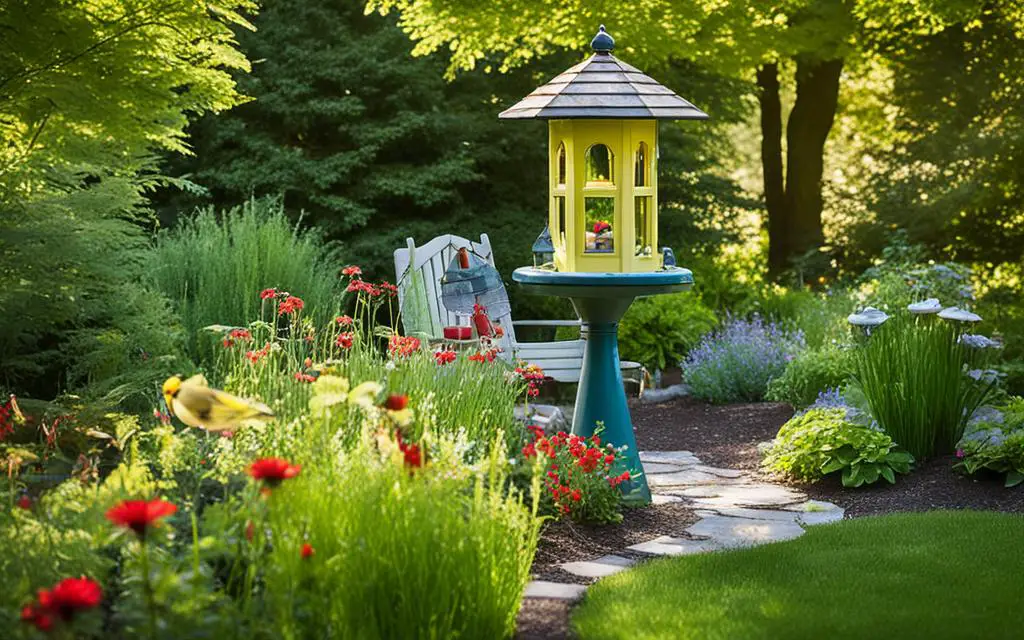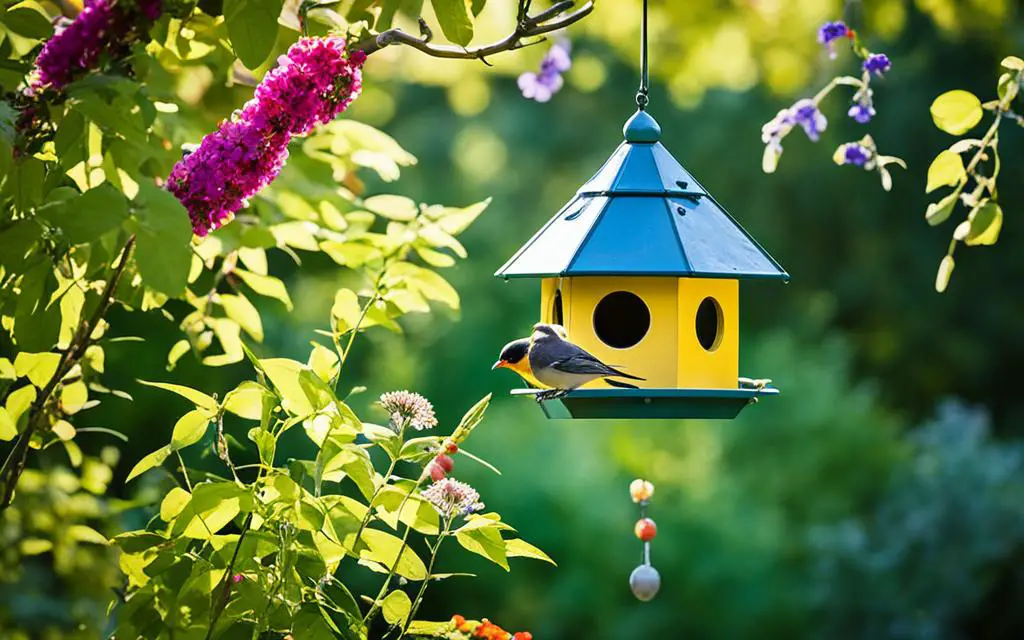Did you know a single bird type can eat up to 500 bugs in one afternoon? This fact highlights the benefits of attracting birds to your garden – it’s a big win. Making your backyard appealing to birds does more than give you a fun hobby. It turns your garden into a lively place full of different species.
By creating special areas for birds, you not only get a beautiful view but also help the environment. This guide will teach you how to make your garden a favorite spot for birds. Your outdoor area will be full of life and song.
Key Takeaways
- Understand the mutual benefits of attracting garden birds, such as natural insect control.
- Create a safe environment with greenery and ample space between food sources to respect birds’ territorial nature.
- Opt for a strategic location that combines the birds’ need for safety with your viewing pleasure.
- Incorporate various bird baths and feeders to cater to different bird species and behaviors.
- Promote diversity in your garden by offering a range of food options to attract a variety of birds.
- Remember, a lively garden is not only a delight but an educational opportunity for all ages.
Understanding Garden Bird Preferences
Exploring garden birds reveals the importance of identifying species for a bird-friendly area. Knowing the feeder and food types each bird prefers can make your garden a lively place for them.
The Influence of Bird Feeder Types on Attracting Birds
The design of a feeder matters a lot for birds’ feeding habits. Watch your garden and notice how finches and chickadees go for tube feeders. Larger birds like cardinals opt for hopper feeders with stable platforms. This shows how feeder preferences vary.
| Bird Species | Preferred Feeder Type | Notable Preferences |
|---|---|---|
| Finches, Sparrows, Chickadees | Tube Feeders | Small perches and enclosed spaces for seeds |
| Cardinals, Jays | Hopper Feeders | Open platforms, large seeds and nuts |
| Woodpeckers, Nuthatches | Suet Feeders | Access to high-energy food sources |
| Grosbeaks, Blue Jays | Ground Feeders | Ground-level feeding, grains and fruits |
| Hummingbirds, Orioles | Nectar Feeders | Specifically designed for liquid nectar |
Importance of Providing a Diverse Diet for Different Bird Species
The variety of feeders and diets you offer affects the birds that visit. Bird-friendly landscaping combines beauty with meeting birds’ dietary needs. Offering different food options brings a variety of birds to your garden. These are some food options to consider:
| Food Type | Bird Species Benefited | Dietary Impact |
|---|---|---|
| Dark Oil Sunflower Seeds | Almost Universal Appeal | High-fat content, suitable for most birds |
| Suet | Woodpeckers, Nuthatches | Crucial energy source, especially in winter |
| Thistle/Nyjer | Finches, Sparrows | Small, oil-rich seeds perfect for small beaks |
| Safflower Seeds | Cardinals, Some Sparrows | Disliked by squirrels, less garden competition |
| Mealworms | Bluebirds, Warblers | Protein-rich, ideal for insect-eating species |
By knowing the feeding habits and needs of different garden birds, you make your backyard more diverse. This helps your local ecosystem. Enjoy watching the birds!
Choosing the Ideal Location for Bird Feeders and Baths
Putting bird feeders and baths in your garden is a great way to watch urban bird watching from home. But, finding the right spot for them is important. It’s not only for your enjoyment but also for the birds’ safety and comfort. To make a safe place for your feathered friends, think about where you put everything.
Picture yourself in your garden, binoculars ready, looking at the birds your bird feeders and baths bring in. They should be in a spot where there’s enough cover but also space. This keeps birds from fighting and lets you watch them easily.
You need to have different feeders at different heights for different birds. Think about how tall to place them. Also, keep them safe from garden predators like squirrels.
| Feeder Type | Height Level | Location Tips | Squirrel-proofing |
|---|---|---|---|
| Tube Feeder | Mid-level | Near bushes for quick escape | Baffle above or pole-mounted at least 5ft off ground |
| Platform Feeder | Low-level | Open space with a clear view | Metal guards or weight-activated deterrents |
| Suet Feeder | High-level | Near tree trunks or sturdy branches | Caging surrounding suet |
| Bird Bath | Ground-level | Visible from a window yet secluded | Place in an area not easily accessible to jumping creatures |
Making a place that welcomes garden birds is always changing. As you get into urban bird watching more, you’ll learn what the birds like. Then, you can adjust your feeders and baths to give them the best place to visit.
Garden Birds and the Role of Water Sources
Creating bird habitats in your garden is rewarding. It helps with wildlife conservation and makes backyard bird watching better. Water is key for a bird-friendly landscape. It gives birds a place to gather, which they need to survive. Watching them play and bathe in these spots is a joy for bird lovers.
Knowing the importance of water for garden birds is crucial. It changes the kinds of birds you see. Adding water features can transform your garden into a haven for birds. Let’s look at how to do this right.
Benefits of Adding Bird Baths and Ponds
Bird baths and ponds do a lot for birds. They help birds stay clean, which is important for flying and keeping warm. A beautiful water feature can be the highlight of your garden. It draws different birds. Ponds encourage ecosystems to grow, offering birds food like bugs and water plants.

Maintaining Clean and Accessible Water for Birds
Keep your water features clean and easy to use to attract birds all year. Cleaning stops disease spread. Having a gentle slope makes bird baths easy for birds to enter. Use a heater in winter to keep water from freezing. This makes your garden a trusted spot for birds when it’s cold.
| Feature | Benefits | Maintenance Tips |
|---|---|---|
| Bird Baths | Space for bathing, helps with feather care | Clean weekly, refill daily, use a heater in winter |
| Ponds | Attracts a wider range of species, encourages a natural food source | Monitor water levels, control algae, protect from predators |
| Moving Water (Fountains or Misters) | Mimics natural streams, visually and audibly attractive | Ensure consistent water flow, prevent clogging, keep the feature powered |
By following these tips and keeping up with maintenance, you can create a bird paradise in your backyard. This effort not only brings joy to your space but also supports wildlife conservation and ecosystems.
Enhancing Your Garden’s Appeal with Bird-Friendly Plants
Making your garden a haven for birds means more than just adding feeders and water baths. Using bird-friendly landscaping means choosing native plants that provide nutritious berries and shelter. This is great for birds and helps your garden’s ecosystem. As you get into bird watching, learning how plants and birds work together can make your garden a lively place for birds. Let’s look at which plants can help turn your garden into a bird haven.

Native Plants That Attract Birds
To attract local birds, it’s best to use native plants. These plants and birds have grown up together, so they’re a perfect match for food and shelter. By having a variety of these plants, you offer what local wildlife needs. This also means you might see many different birds right from your home.
Colorful Blooms and Berries: A Magnet for Winged Guests
In bird landscaping, colorful and berry-filled plants are key. Birds look for these signs when they’re searching for food. To bring many bird types to your garden, include plants with bright flowers and fruits. Let’s review some options that are both pretty and good at attracting birds.
| Plant Type | Features | Birds Attracted |
|---|---|---|
| Shrubs | Dense foliage, berries | Waxwings, Sparrows |
| Trees | High perches, acorns | Woodpeckers, Jays |
| Evergreens & Vines | Year-round coverage, berries | Finches, Thrushes |
Choosing and placing these plants thoughtfully, you’re not just creating a garden. You’re building a habitat for birds throughout the year. As seasons change, your garden remains a sanctuary for birds. Enjoy the natural music from your feathered visitors.
Establish Shelter and Protection for Garden Birds
Getting into backyard bird watching means providing safe homes for birds. It’s vital to have spots for creating bird habitats where birds feel secure. By making your garden welcoming and bird species identification a hobby, you’ll see more birds coming. This article explains how to give the best shelter and care for your feathery friends.

Shelter is a top priority for setting up your garden. Getting birdhouses that meet the needs of your desired birds helps attract many types. You should think about having different birdhouses. This way, you can host small wrens and big woodpeckers alike. Nesting boxes offer warmth and keep birds safe from predators. It’s good to place them on poles or secured trees where it’s safe. This tells birds your yard is more than a stopover—it’s a home.
But making homes for birds is more than just food and water. It’s about noticing who visits and making homes just right for them. Make sure the entrance is the right size to keep big birds out. Putting homes near greenery helps them escape from danger quickly. This gives them the safety to grow.
Becoming great at backyard bird watching involves more than setting up shelters. It’s a commitment to bird species identification and making good homes. This dedication turns your garden into a true haven for all bird types, big and small.
Providing Nesting Opportunities to Entice Avian Tenants
Want your garden to be a seasonal haven for birds? Know that it takes more than just looks. Learning about bird species and creating suitable habitats is key. You must offer food, safety, and breeding spots to invite birds to call your yard home.
Creating an Inviting Nesting Environment
To make a garden where birds can flourish, consider what they need. Dense plants and well-placed birdhouses offer them safety and a place to live. Choose the right plants and feeders to attract different birds year-round. This makes a sanctuary for birds and a paradise for bird watchers.
Supplemental Nesting Materials to Support Bird Families
Adding extra materials can help birds a lot. Offering twigs, strings, or pet fur in a feeder simulates natural nest-building resources. Watching what materials birds prefer helps you make your garden their favorite nesting spot. This way, you play a big part in growing the bird population from your own backyard.
FAQ
How can I attract birds to my garden?
What types of bird feeders should I use to attract garden birds?
Why is it important to offer a diverse diet to birds?
Where should I place my bird feeders and baths?
How do water sources benefit garden birds?
What are some bird-friendly plants to add to my garden?
What colors attract birds to the garden?
How can I provide safe shelters for birds in my garden?
How can I encourage birds to nest in my backyard?
Should I provide supplemental nesting materials for birds?

My name is Shane Warren, the author behind Your Bird Buddy – your ultimate guide to the wonderful world of birds! Unleash your inner avian explorer as we delve into a vibrant library of knowledge dedicated to all things feathered. From learning about diverse bird species from across the globe to understanding their captivating habitats and behaviors, I’m here to fuel your passion for these magnificent creatures. Not only that, but I also provide valuable insights on being a responsible and informed pet bird owner. Join our vibrant community and let’s celebrate the feathered wonders of the world together – one chirp at a time. And be sure to join our Your Bird Buddy Community over on Facebook!


Comments are closed